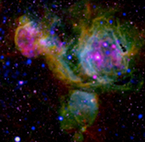Stars form in great
dark clouds of cold gas and dust. As one after another lights up, new stars mark their environment, breaking apart molecules,
stripping electrons from atoms, and heating tiny
dust grains until they glow. Stars eventually die, some of them exploding in the very same place they were born. The interplay of stellar birth and death is an intricate, dynamic process which leaves its mark over a wide swath of the
electromagnetic spectrum. A particularly beautiful example is the region called N51 in the Large Magellanic Cloud, seen above in a composite image of optical, infrared (from the
Spitzer Space Telescope) and X-ray (from the
XMM-Newton X-ray Observatory) light. The optical image shows young stars and glowing ionized gas around them; warm dust glows in the infrared, while the hottest gas at temperatures of millions of degrees produces bright X-ray emission. A giant shell on the right seen in the optical is a superbubble called N51D, blown by the winds of embedded massive stars and perhaps supernovae from a generation of very massive stars which died within the bubble. It is filled with hot gas glowing in X-rays. Another
supernova remnant filled with hot, X-ray emitting gas is seen on the left of the complex. Observations like these help astronomers obtain the complete picture of how stars form and die, and how this process helps drive the
evolution of galaxies.
 HEAPOW: The Birth and Death of Stars (2012 Jul 23)
HEAPOW: The Birth and Death of Stars (2012 Jul 23)